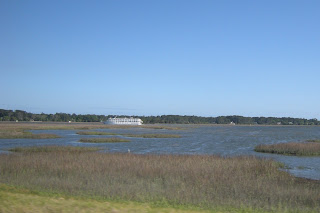We drove into Savannah and visited the museum at the visitor center for a little Savannah history. They had an excellent film. We got aboard the Old Town Trolley, an on and off trolley that gives a stream of information along the way. Between the trolley and the visitor center museum we learned a lot about Savannah and loved it all. Oglethorpe got a group together to fund the beginning of a colony in Georgia with the British Parliament’s blessing. Oglethorpe and his group of 116 settlers arrived in what is now Savannah in 1733. He had a grand idea to set out the city in 24 squares with a park in the center of each one. There are still 22 of the squares today. He set up a ten acre experimental farm to see what crops would be successful. Cotton, rice, indigo and peaches topped the list. You can see where the farm was but it is just an open field today. The garden club should get busy. Soon more emigrants were on their way. He agreed to take convicted prisoners. I guess they worked out okay. He had a list of four no no’s for the new colony; 1. no slavery, 2. no lawyers (people could settle their differences among themselves), 3. no alcohol other than beer, wine and lager, and 4. no practicing Catholics. Well, Catholics built a beautiful church by the late 1700’s, you can walk around town with alcohol in plastic cups, lawyers have offices in some of the grand old buildings, and of course slavery became a reality. The cotton gin was perfected by Eli Whitney on a plantation nearby and with that came slavery. The plantation owners could not keep up with the work without slaves once the processing became faster with the cotton gin. Those opposed to slavery finally conceded. Beautiful homes replaced most of the small pre-Revolutionary homes to make what is now a beautiful walking district. The Cotton Exchange faced the river with the warehouse down below on the wharf and the cotton merchants on the upper level. The merchants would ring a bell much like the stock exchange today when selling was going to take place. The bell is still there but the Cotton Exchange is tourist shops and restaurants. The city’s buildings survived the Civil War. The Confederates knew there was no stopping Sherman as he raged through the south burning a path as he went. They surrendered. President Lincoln received Savannah as a Christmas present from Gen. Sherman and the war was essentially over.
 |
| Ogalthorpe - Founder of Savannah |
 |
| First Brick Building in Savannah - Now Part of a Pub |
 |
| List of Buyildings etc. in 1779 |
 |
| Cotton Exchange Bell Cotton Exchange is in the back ground. |
One story I really liked was the building of the first brick Baptist Church built by slaves for their own place of worship. They would walk eight miles from surrounding plantations into town at the end of their long day to work on the church. Each brick was made down by the Savannah River and carried by women to the building site. The walls were four bricks thick. Then they would trudge the eight miles back for the next work day in the cotton fields. It was finished in 1859. Amazing drive and dedication. They are raising money now to do some refurbishing.
 |
| First Baptist Church built by Slaves |
Our dedication was aimed at eating at Paula Deans, The Lady and Sons. You go by the restaurant in the morning to get a reservation for that day. First thing this morning we got our time and at 2:00 we were having fried chicken and the full on southern meal.
 |
| Paula Dean's Lady and Sons Restaurant |
Norm drove me around so I could get some pictures of some of the places we had seen on our tour. We ended up down on the water front to get a picture of the “Waving Lady” statue. The story goes that she was the sister of a lighthouse keeper and she would wave to all the incoming and outgoing ships. She did this without fail, greeting over 50,000 ships over a period of 44 years until she died in 1943. Dedication once again.
 |
| Waving Lady Statue |
 |
| Olympic Torch from the Olympics Check out the huge ship coming up the Savannah River. |
 |
| Leopolds |
 |
| It doesn't look like a mid sized cruise ship could come up this waterway. |

No comments:
Post a Comment